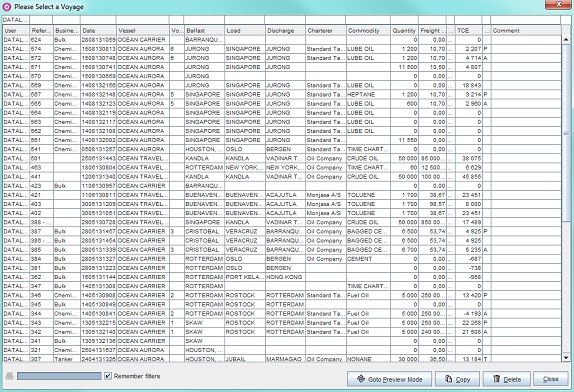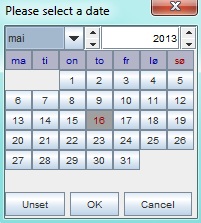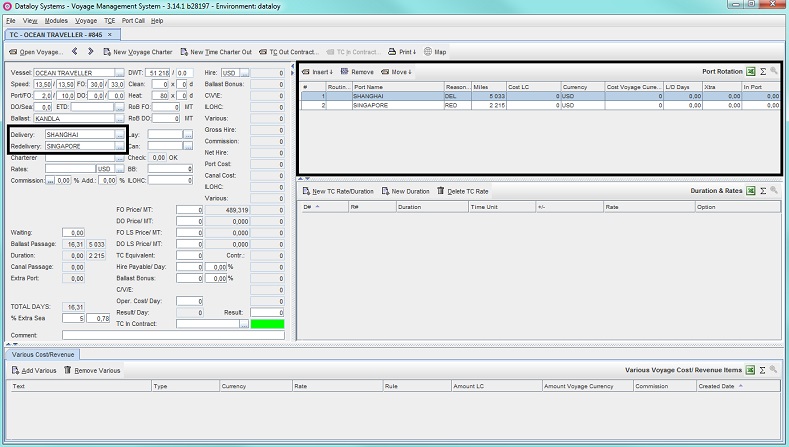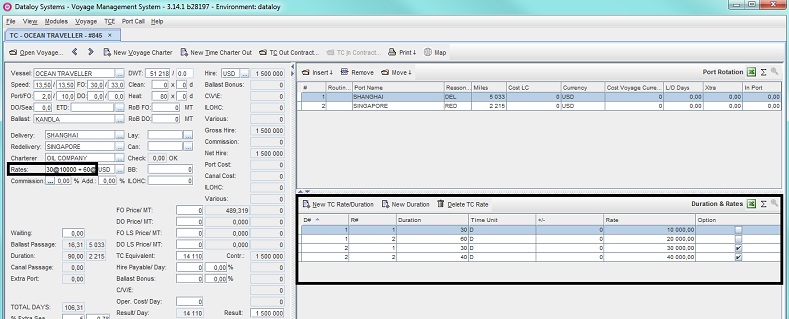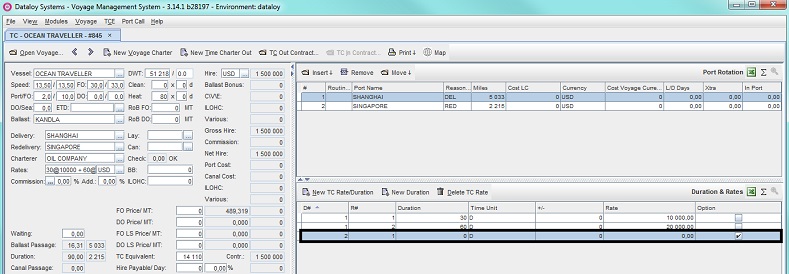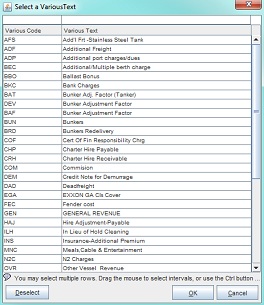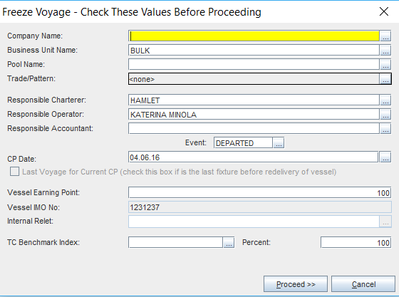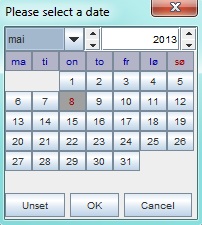Create Time Charter Calculations
Short Description
The Voyage Estimate module allows for an unlimited number of time charter calculations, both simple and complex, in order to calculate profitability of potential voyages in comparison with the cost of a vessel. Each calculation is identified by a unique number, are auto-saved and can be shared, copied and if needed, retrieved at a later date.
The time charter calculation interface consists of four main sections.
- Main Calculation Field:
- The full calculation panel - used to calculate and estimate the need of a voyage. Enables quick calculations and will at any time display the most important vessel details, hire details, duration breakdown, relevant fuel consumption and price and a result panel, which at any time displays the contribution, TC equivalent and the profit and loss of a voyage, including a breakdown for all cost and revenue.
- Port Rotation:
- Displays all relevant port calls and routing points of an estimated time charter, including delivery port, redelivery port, all port calls prior and after delivery-redelivery, port cost, etc.
- Duration & Rates:
- Displays all duration and rates of an estimated time charter, including time duration flexibility, if a duration/rate is optional or not, etc.
- Various Voyage Cost/Revenue Items:
- Displays all cost/revenue items related to the voyage applicable to the vessel owner.
Voyage estimates are mainly entered either as new or based on the copy of an already existing one. For quick calculations all details need not be entered, but for calculations to become fixtures should be as detailed as possible before freezing. As data is entered different sections of the estimate panels will automatically update and self-populate with data based on elsewhere entered parameters (by user or retrieved from other modules), as will related areas and in the Port Rotation, Duration & Rates and Various Voyage Cost/Revenue Items fields. At any time the panel will display the voyage calculation breakdown of various subtotals and will automatically recalculate and update data whenever parameters change. Also, if rates change in the TC COntract, any offhire amounts will automatically recalculate to ensure correct resultsin the estimate.
An estimate can be simple, for example a delivery port and a redelivery port or consist of a combination of multiple port calls and routing points (Advanced Port Rotation (Routing) (TC)). The Time Charter Equivalent (TCE) is calculated by dividing the contribution by the total voyage duration in days.
All estimates can be frozen and transferred to the Bookings and Operations module for execution, thereby becoming Actual Voyages (or fixtures). Once frozen, Dataloy VMS also automatically generates a voyage number, a schedule and a live copy of a calculation. The original calculation is saved as the Preliminary Calculation displaying all initial estimates - cannot and will not change. A live copy of the calculation form the basis of the Adjusted Calculation. See the Post Voyage Analysis page on how to generate a detailed analysis of the Adjusted Calculation including a comparison with the Preliminary Calculation.
Navigation Tips and Additional Features
Automatic Quick Search of Vessel and Port Names
Only the first few characters of a vessel name or port need to be entered under Vessel and Port respectively in the Main Calculation field. Dataloy VMS will search available vessels and ports and display the first matching entered characters, for example enter "VISAK" and "VISAKHAPATNAM" displays.
Moving Between Fields
- Use <Tab> or <Enter> for quick navigation between fields.
- Use <Shift-Tab> to move backwards between fields.
- Use <Tab> to move from column to column in a table/list.
- Use <Enter> to move from row to row in a table/list.
Information Dialogue Boxes
Certain fields have hidden information boxes attached. Hover the cursor over such a field and and information sign will display indicating availability of further data about the field contents retrieved from other modules. Click the sign to open available information dialogue box. Note: The contents of the dialogue box can only be altered in the module it is retrieved from.
Chapters:
Long Description
Create a Time Charter Out Calculation/Estimate
Go to
Modules > Voyage Estimate.The Voyage Estimate window opens.
Note: The most recent calculation will by default display. If no previous calculation has been made - the view will be empty.
Example:- A new time charter out calculation can be made either by creating a new one or by duplicating an existing one. Each option requires the prior existence of minimum one vessel in Dataloy VMS.
- Create a time calculation by
- entering a new time charter out calculation
- Either
- click New Time Charter Out
- or go to the Voyage menu and from the drop-down select New Time Charter Out
- click New Time Charter Out
- A blank time charter calculation window will display. Go to Step 3.
- Either
- or by duplicating an existing one
- Either
search and duplicate an open voyage
Open the voyage to be duplicated:
Click Open Voyage. The Select a Voyage pop-up with a list of previously entered calculations will open.
Double-click the voyage row to be opened. The calculation will open.
Go to the Voyage Menu and from the drop-down select Duplicate.
- The duplicated voyage calculation hold the same data as the voyage it was duplicated from - except the calculation number (unique for each calculation) at the top of the tab.
- or copy a voyage from the Select a Voyage pop-up.
- Click Open Voyage. The Select a Voyage pop-up with a list of previously entered voyage calculations opens.
Note: Displays by default only a user's own calculations. Can be filtered to display all previous calculations.
Example: - Filter (if applicable) to locate the voyage to be duplicated.
- Select the row of the voyage to be duplicated.
- Click Copy. The pop-up will close and a copy of the selected time charter calculation display.
Note: The copied voyage will show different voyage results depending on the voyage type copied. Estimates and budget voyages that have cargoes with bunker adjustment (BAF) amounts does not have the BAF prices copied rendering the calculated amount zero. Actual Voyages inherits the bunker ROB, the previous voyage's prices in the schedule and the bunker prices. For time charter (TC) voyages any profit/loss will be recalculated. Go to Step 3.
- In the left-hand Main Calculation field, fill in the fields as follows (as applicable - duplicated time charter calculations: edit as applicable):
Note: As data is entered different sections of the main calculation field panels will automatically update and self-populate as will related areas and in the Port Rotation field. - In the Vessel panel:
- Enter either
- the name of the vessel a calculation is to be made for under Vessel
Note: Recommended: Need only to enter the first few characters of the vessel name. Dataloy VMS will search amongst available vessels and display the first matching entered characters. - or click the Triple Dot Selector next to the field. A pop-up with a list of input values will open. Select field and click OK.
Example: - Once a vessel has been the panel's fields will automatically populate with data retrieved from the Vessel Administration module except for the ETD, Ballast port, RoB or DoB.
Note: Ballast port is NOT automatically retrieved to avoid misleading confusion of it being the current bunker situation.
Example: - All the populated fields can be manually entered/overridden - edit if applicable:
- Enter the ballast speed/day and speed when loaded under Speed.
- Enter the fuel oil (FO) consumption/day while idle in port and while working in port under Port/FO.
Enter the diesel oil (DO) consumption at sea/day under DO/Sea.
Enter the ballast fuel consumption (FO)/day and when loaded under FO.
Enter diesel oil (DO) consumption/day while idle in port and while working in port under DO.
- Enter either
the estimated voyage start date under ETD (Estimated Time of Departure, i.e. vessel availability date)
or click the Triple Dot Selector next to the field. A pop-up with a calendar will open. Select date and click OK.
- Enter the ballast port (i.e. vessel starting point) under Ballast.
Note: Dataloy VMS automatically verifies port availability in the system. If not verified - please contact Dataloy to add port to system. - Enter the deadweight/metric tonne (MT) under DWT.
- The Draft field next to the DWT will activate upon vessel entry and populate with draft data retrieved from the Vessel Administration module.
Note: Field is always disabled from editing. It can ONLY be edited from the Vessel Administration module. - Enter the fuel consumption in metric tonnes (MT)/day and number of days for cleaning under Clean.
- Enter the fuel consumption in metric tonnes (MT)/day and number of days for heating/cooling of cargo under Heat.
Note: Indicates fuel consumption for heating/cooling cargo, for example gas cooling. Calculated by multiplying the number of tonnes with the number of days. Enter the fuel oil (FO) remaining on board at voyage start date (leaving ballast port) under RoB FO (Remain on Board Fuel Oil).
Enter the diesel oil (DO) remaining on board at voyage start date (leaving ballast port) under RoB DO (Remain on Board Diesel Oil).
- In the Time Charter (TC) Contract panel:
- Fill in the fields as follows:
- Enter the delivery port under Delivery (RED marking = required field).
Note: Need only to enter the first few characters of the port name. Dataloy VMS will search available ports and display the first matching entered characters, for example enter "VISAK" and "VISAKHAPATNAM" displays. - Enter the redelivery port under Redelivery (RED marking = required field).
Note: A minimum of one delivery and one redelivery port must be entered. Once entered, the delivery and redelivery ports will automatically display in the Ports Rotation field, (including reason for call (RED, DEL, etc.) and the distances between ballast, delivery and redelivery ports). To enter multiple port calls, extra ports and/or additional routing points, go to Advanced Port Rotation (Routing) (TC).Example:
- Enter the delivery port under Delivery (RED marking = required field).
- Enter the charterer (customer) under Charterer.
- Enter all estimated duration and rates under Rates.
Note: Enter new data as: TIME@PRICE/DAY, for example write "30 days at the price of 10,000/day" as: 30@10,000. Multiple duration and rates entries are separated by a plus ("+"). Example: 30@10,000+60@20,000. To indicate that a duration and rate is optional: entry/entries are preceded by a comma (","). If more than one is optional - enter as multiple entries after the comma. Example: 30@10,000+60@20,000, 30@40,000+60@40,000. Entered duration and rates string automatically displays in the Duration & Rates field, (including duration, time unit (days (D) or months (M)) and rate). Additional non-optional duration and rates entries following optional entries must be entered manually in the Duration & Rates field, which will by default display as optional - uncheck Option to render entries non-optional. Change of time unit (days (D) or months (M)) can only be made in the TC Out Contract... dialogue box.
Example:
Duration & Rate string: 30@10,000+60@20,000, 30@40,000+60@40,000 (the two latter optional, indicated by checked Option box in the Duration & Rates field)
- Enter rate currency in the rate currency field beside the Rates field.
Note: Defaults to hire currency.
- Enter the total of all broker commissions (in per cent) under Commission.
Note: Broker commissions should be specified if an estimate is to be made into an Actual Voyage (fixture). Usually performed after calculation completion, prior to freezing.- Specify broker commissions (if applicable):
- Click the Triple Dot Selector next to Broker Commissions field. The Broker Commissions dialogue box opens.
- Click Create New. An empty broker specification row will appear.
Example: - Fill in the row fields as follows:
- Enter the broker under Broker.
- Enter the commission percentage under Percent.
- Enter the commission rate (if applicable) under Rate.
Note: Rate is multiplied with cargo quantity. - Enter applicable lumpsum (if applicable) under Lumpsum.
- Enter the commission under Commission.
- Check Credit Charterer to indicate that the Charterer will pay the commission to the broker (deducted when invoicing).
- Check C/O (care/of) to indicate that invoices should be sent through the broker (i.e. the broker is invoice addressee).
- Basefreight Only checkbox is not applicable for time charter calculations and should be left blank.
- Enter the commission type under Commission Type.
- Repeat as applicable until the total broker commission has been split and specified amongst all involved brokers.
- Click Close. The dialogue box will close and entered data apply. The total commission percentage according to the display in the Broker Commissions field.
- Delete a broker commission specification:
- Click the broker commission row to be deleted - it will highlight.
- Click Remove. A pop-up opens asking to confirm removal.
- Click Yes. The selected broker commission will delete.
- Specify broker commissions (if applicable):
- Enter the address commission (in per cent) under Add (Address Commission).
- Enter the start date for lay/can spread under Lay.
- Enter the end date for lay/can spread under Can.
- Check field self-populates will state the how much lay/can time is missed by. If within lay/can spread: will state 0.00 and OK.
- Enter the agreed ballast bonus lumpsum (if applicable) under Ballast Bonus.
- Enter the agreed ILOHC lumpsum (if applicable) under ILOHC (In Lieu of Holds Cleaning).
Note: Only one ILOHC lumpsum can be entered into the contract. - In the Duration & Rates field enter all applicable duration and rates that have not been entered under Rates (Main Calculation field):
Note: Duration refers to a time period a vessel is chartered under a TC contract. A duration can have one or more rates and each added duration is numbered in sequential order. The first entered duration will therefore be labeled 1, the second 2, etc. The Duration & Rates field displays as rows the duration and rates string entered under Rates (Main Calculation field) and any manually entered (a new duration and rate and/or a new rate to an existing duration). If no changes are required – go to Step 5.
Example:
- Add a new duration and rate:
- Either
- click New Duration
- or go to the TCE menu and from the drop-down select New Duration.
- click New Duration
- A new duration and rate displays as a row in the Duration & Rates field.
Note: Each added duration and rate are numbered in sequential order. The first entered duration and rate will therefore be labeled 1, the second 2, etc.
Example:
Duration (D#) 2, Rate (R#) 1- Fill in the row fields as follows (except the read-only D#, R# and Time Unit fields):
- D# field lists the duration number
Note: Each added duration is sequentially numbered according to order of entry. - R# field lists the rate number.
Note: Each added rate to a duration is numbered in sequential order according to order of entry. - Enter the rate duration under Duration.
- Time Unit displays unit time is to be measured in.
Note: Defaults to days (D). Change of time unit (days (D) or months (M)) can only be made in the TC Out Contract... dialogue box. - Enter the time duration flexibility (always in days) under +/-.
Example: A vessel is chartered for 90 days +/- 15 days
- Check Option to indicate if the duration period is optional.
Note: CANNOT be used for the initial duration period or if the TC contract only consists of one duration period. Should then be left blank.
- D# field lists the duration number
- Fill in the row fields as follows (except the read-only D#, R# and Time Unit fields):
- Repeat as applicable until all applicable durations have been entered.
- Go to Step 5.
- Either
- Add a new rate to an existing duration:
- Click the duration to add a rate to - it will highlight.
- Either
- click New TC Rate/Duration
- or go to the TCE menu and from the drop-down select New TC Rate/Duration.
- The new rate displays as a row in the Duration & Rates field.
Note: Each added rate is numbered in sequential order according to order of entry to the duration it belongs to. The first entered rate will therefore be labeled 1, the second 2, etc.
Example:
Duration (D#) 1, Rate (R#) 2- Fill in the row fields as follows (except the read-only D#, R# and Time Unit fields):
- D#field lists the duration number
Note: Each added duration is sequentially numbered according to order of entry. - R# field lists the rate number.
Note: Each added rate to a duration is numbered in sequential order according to order of entry. - Enter the rate duration under Duration.
- Time Unit displays unit time is to be measured in.
Note: Defaults to days (D). Change of time unit (days (D) or months (M)) can only be made in the TC Out Contract... dialogue box. - Enter the time duration flexibility (always in days) under +/-.
Example: A vessel is chartered for 90 days +/- 15 days
- Check Option to indicate if the duration period is optional.
Note: CANNOT be used for the initial duration period or if the TC contract only consists of one duration period. Should then be left blank.
- D#field lists the duration number
- Fill in the row fields as follows (except the read-only D#, R# and Time Unit fields):
- Repeat as applicable until all applicable rates have been entered.
- Go to Step 5.
- Delete a Rate:
- Click the row with the rate to be deleted - it will highlight.
- Either
- click Delete TC Rate
- or go to the TCE menu and from the drop-down select Delete TC Rate.
- click Delete TC Rate
- A pop-up opens asking to confirm removal.
- Click Yes. Selected TC rate row will delete.
- In the left-hand Main Calculation field, fill in the fields as follows (as applicable - duplicated voyage calculations: edit as applicable):
- In the Turnaround Days (or Duration of Voyage) panel:
Note: Only the Waiting and % Extra Sea fields can be edited. All other fields are read-only and will (if applicable) self-populate with data based on elsewhere entered parameters (by user or retrieved from other modules). At any time the panel will display the total length of a voyage (in days with a voyage breakdown) and will automatically recalculate and update data whenever parameters change.- Fill in applicable fields, all other fields self-populate:
- Enter extra time spent waiting before entering the first port (in days) under Waiting (if applicable).
- The Ballast Passage fields displays the time (in days) and distance (nautical miles) between ballast and the delivery ports as well as any time after the redelivery port.
- The Duration field displays the total time duration (in days) of a voyage that the vessel is chartered (used when calculating revenue).
Note: Excludes optional durations. - Canal Passage displays the total time of canal passage (if any).
- Extra Port displays the total extra time spent entering/leaving ports.
Note: Displays the total number of entered days in all ports under the Xtra column in the Ports field. - TOTAL DAYS displays the total duration of the voyage (in days).
- Enter the number of extra days at sea as per cent (first field) or in days (second field) under % Extra Sea.
Note: Normally defaults to 5% - the second field automatically displays the entered percentage in days (and vice versa). - Enter additional comments (if any) under Comment.
- Fill in applicable fields, all other fields self-populate:
- In the Fuel panel:
Note: Calculates the total cost of each bunkers type (FO, DO, FO LS and DO LS) for a vessel's ballast passage ONLY, i.e. to get from ballast port to delivery port (includes any extra ports prior to reaching delivery port). Each bunker type row is divided into three fields, one for fuel price/MT, the next states consumption of the bunker type in metric tonnes needed to complete a ballast passage and the third displays the total bunker type cost for the estimated ballast passage. Only the first field, "fuel price/MT" , can be edited, all other fields are read-only and will self-populate. The panel will automatically recalculate and update upon parameter change.- Fill in the fields as follows (as applicable):
- Enter the estimated fuel oil (FO) price/MT under FO Price/MT.
- Enter the estimated diesel oil (DO) price/MT under DO Price/MT.
- Enter the estimated fuel oil low sulphur (FO LS) price/MT under FO LS Price/MT.
- Enter the diesel oil low sulphur (DO LS) price/MT under DO LS Price/MT
- Each entered bunkers cost/MT will automatically multiply by the bunker consumption of its respective row. The product of each will display as the cost of the required fuel consumption for an estimated ballast passage.
Example:
827 x 489,319 = 404 667 (i.e. bunker type price/MT multiplied by required bunker consumption equals total cost of required bunker type consumption to complete ballast passage).
- Fill in the fields as follows (as applicable):
- In the Turnaround Days (or Duration of Voyage) panel:
- In the Port Rotation field:
Enter the individual port costs for all ports in the Cost LC column row fields of the upper right-hand Port Rotation field.
Note: Entry of port costs of the delivery and redelivery ports (and any port in between) are not required as they are paid for by the Charterer. Port costs for any extra ports between ballast port and delivery port should be entered, for example port call for bunkering. The sum of all port costs will automatically display under Port Cost in the Upper Result Panel of the Main Calculation field.
Example:Repeat until all applicable port costs have been entered.
Enter the individual extra days estimated to spend in each port in the Xtra column of the upper right-hand Port Rotation field.
Note: ONLY applicable to ports prior to delivery port and after the redlivery port. Defaults to 0.5 days. The total of all entered extra time spent in all port will display under Extra Port (Main Calculation field, Turnaround panel).
- In the Various Voyage Cost/Revenue Items field:
- Enter all individual various cost and/or revenues for the voyage (as applicable) in the Various Cost/Revenue Items field:
- To add a cost/revenue:
Click Add Various...
- The Select a Various Text pop-up with a list of input values will open. Select applicable cost/revenue and click OK.
Example: - The pop-up will close and selected item will display as a populated row in the Various Cost/Revenue field.
Note: Item row contents will follow configuration as (user) entered in the Various Text module.
Example: - The populated row fields can be manually overridden (except Amount LC, Amount Voyage Currency and Created Date) - edit if/as applicable:
- Enter the name of the various cost/revenue under Text.
Enter the monetary transaction type under Type.
Transaction Types: Cost (C) An item's value will be accumulated to the total Various Cost item of a voyage. Revenue (R) An item's value will be accumulated to the total Various Revenue item of a voyage. Both (B) An item's value will be accumulated to the total Various Cost and Revenue item of a voyage. - Enter applicable currency under Currency.
- Enter cost/revenue depending on rule under Rate.
Note: Relevant fields will automatically update, including the Amount LC and Amount Voyage Currency fields. Enter the appropriate default calculation rule under Rule.
Calculation Rule Types: Lumpsum (L) The amount entered against the item will be treated as a lumpsum (no calculation takes place).
Per Day (D) Entered value will be multiplied with the total number voyage days.
Percentage (P) Entered value will be multiplied with the freight of for example a cargo and then divided by 100.
Rate Based (R) Entered value will be multiplied with the quantity of for example a cargo against which the item is added.
- Amount LC (Amount Local Currency) displays the total cost/revenue in applicable currency.
- Amount Voyage Currency displays the total cost/revenue in the voyage currency.
- Check Commission to indicate if Address Commission applies to the cost/revenue.
- Created Date displays the date the cost/revenue was added.
- Repeat as applicable until all various costs/revenues have been entered.
- Delete a various cost/revenue:
- Select the cost/revenue to be deleted - it will highlight.
- Click Remove Various.
A pop-up opens asking to confirm removal.
Click Yes. The selected item will delete.
- To add a cost/revenue:
- Enter all individual various cost and/or revenues for the voyage (as applicable) in the Various Cost/Revenue Items field:
In the left-hand Main Calculation field, fill in the fields as follows (as applicable - duplicated voyage calculations: edit as applicable):
- In the Upper Result panel:
Note: Only the hire currency field next to Hire can be edited. All other fields are read-only and will (if applicable) self-populate with data based on elsewhere entered parameters (by user or retrieved from other modules). At any time the panel will display the time charter calculation breakdown of cost/revenue subtotals (exception: any cost/revenue handled in the Fuel and Lower Result panels respectively) and will automatically recalculate and update data whenever parameters change.- Fill in applicable field, all other fields self-populate:
- Enter hire currency in the hire currency field next to Hire.
- The Hire field (second field under Hire ) displays the total the total hire.
- Ballast bonus displays the total ballast bonus.
- Upper C/V/E displays the total C/V/E paid by the Charterer.
- Upper ILOHC (In Lieu Of Hold Cleaning) displays in advance agreed lumpsum cost for not cleaning vessel prior to re-delivery. paid by Charterer.
- Upper Various field displays the total of all various revenues.
- Gross Hire displays the sum of the Hire, Ballast Bonus, C/V/E and upper Various fields.
- Commission displays the total of broker and address commissions.
- Net Hire displays the difference of Gross Hire total minus Commission totals.
- Port Cost displays the total of all voyage port costs.
- Canal Cost displays the total of all canal costs (if any).
- ILOHC (In Lieu Of Hold Cleaning) displays in advance agreed lumpsum cost for not cleaning vessel prior to re-delivery. (Retrieved from applicable TC In contract. Otherwise - will be blank).
Note: Will only populate if voyage is frozen and if Final Voyage box is checked in the Freeze Voyage - Check These Values Before Proceeding pop-up during the final voyage before vessel re-delivery. ILOHC can be added to a calculation for other voyages if added via the Various Voyage Cost/Revenue Items field.
Lower Various field displays the total of all various costs.
- Fill in applicable field, all other fields self-populate:
- In the Lower Result panel:
- Fill in the fields as follows (where applicable), read-only fields self-populate:
- The TC Equivalent (Time Charter Equivalent) displays Contribution divided by total days.
- Note: Can be manually overridden. If changed, the entered hire rate will recalculate and display the rate needed to achieve the new TC Equivalent. If multiple rates - will ONLY recalculate the first entered rate (displays in the Duration & Rates field).
- Check Reverse Calculation to lock the TC Equivalent figure.
Note: Leave UNCHECKED if estimate is to be made a fixture.Used when performing reverse calculations - otherwise leave unchecked. Reverse calculation: A locked TC Equivalent causes changes made in a calculation (other than the rate) to impact on the hire rate, not the result. - Contr. (Contribution) displays Net Hire total minus the total of all costs prior to deducting vessel costs.
- Enter vessel hire/day (first field) and applicable address commission (in per cent) (second field) under Hire Payable/Day.
Note: Both fields will automatically populate if vessel is under Time Charter In contract. If so, fields CANNOT be edited. - The Total Hire Payable/Day field next to the Hire Payable/Day fields displays the net hire payable (i.e. hire payable minus address commission).
- Enter ballast bonus (first field) and address commission (in per cent) (second field) under Ballast Bonus.
Note: Always a lumpsum. Will automatically populate if vessel is under TC In contract. If so, CANNOT be edited. - The Total Ballast Bonus field next to the Ballast Bonus fields displays the net ballast bonus (i.e. ballast bonus minus address commission).
- C/V/E (Cables/Victuals/Entertainment or Meals & Cables) displays the total of all C/V/E costs.
Note: Retrieved from the Time Charter Contracts module. - Enter the vessel's operational cost/day under Oper. Cost/Day (Operational Cost/Day).
Note: Will also display to the left. - Result/Day displays the voyage estimate's net result/day.
- Result displays Contribution minus vessel costs.
Note: Cannot be locked, but can be manually overridden. Can perform Breakeven calculations: Enter 0 and the hire rate will recalculate and display required rate for a voyage to end plus/minus zero. - Enter applicable TC In Contract (if any) under TC In Contract.
Note: Will automatically populate if vessel is under TC In contract upon vessel name entry (Vessel panel) stating the charter date. Retrieved from the Time Charter Contracts module. Can be manually overridden. If populated, the TC In Contract button in the top toolbar will activate - click to open pop-up with main details of contract.
- Fill in the fields as follows (where applicable), read-only fields self-populate:
- In the Upper Result panel:
- The Time Charter Calculation is complete. To freeze a calculation and turn it into a fixture, go to Turn a Time Charter calculation into an Actual Voyage
Turn a Time Charter Out Calculation Into an Actual Voyage
- Specify the broker commissions entered in the Time Charter (TC) Contract panel of the Main Calculation field (if applicable) by following the step-by-step instructions of the Create a Time Charter Out calculation/estimate, Step 3bi 6a above.
- Go to the Voyage menu and from the drop-down select Freeze.
- The TC Out Contract dialogue box opens.
Example: - Review and enter relevant details in each respective tab as per applicable instructions on the Time Charter Contracts page (under To enter a Time Charter (TC) In Contract).
Note: Quick calculations need not have all details entered, but calculations to become fixtures should be as detailed as possible before freezing. The contents of the TC Out Contract dialogue box tabs is the same the that of the Time Charter Contracts page tabs. The same details need to be added to a time charter, irrespective of it being a TC In or Out. - Once all relevant details have been added, click Proceed. The dialogue box will close and the Freeze Voyage - Check These Values Before Proceeding pop-up open.
- Fill in the fields as follows:
- Enter either
- the name of the company responsible for the voyage under Company Name
- or click the Triple Dot Selector next to the field. A pop-up with a list of input values will open. Select field and click OK.
- Enter the business unit responsible for the voyage under Business Unit Name.
- Enter the pool responsible for the voyage (if applicable) under Pool Name.
- Enter applicable trade route under Trade/Pattern.
- Enter the person responsible for the voyage under Responsible Charterer.
- Enter the person responsible for operating the voyage under Responsible Operator.
- Enter the responsible accountant under Accountant Responsible.
Note: Defaults to data in Vessel Administration > Internal Data - if entered. - Enter the event the time the TC should start from under Event.
- Enter either
- the charter party (CP) date under CP Date (MANDATORY)
- or click the Triple Dot Selector next to the field. A pop-up with a calendar opens. Select date and click OK.
- Check Last Voyage for current CP if vessel is under TC In contract and on its final voyage prior to re-delivery. Otherwise - leave UNCHECKED.
Note: If left unchecked the voyage performed by the vessel prior to redelivery is not marked as the last - the VMS will expect a new fixture to be created. - Enter the vessel earning point under Vessel Earning Point.
Note: ONLY used to override if the vessel used in the time charter calculation has a different vessel earning point than the intended vessel for the time charter. - The Vessel IMO No field displays a vessel's IMO number. It will always be disabled.
Note: Depending on system configuration on mandatory IMO number, if a vessel does not have an IMO number an error message will display and an IMO should be set in the Vessel Administration module. - The Internal Relet section should be left blank.
Note: This field will by default be disabled - it will ONLY activate if the voyage is performed by a Time Charter (TC) In vessel AND the selected business unit in the freeze picture is other than business unit in the time charter (TC) contract. - Enter the index against which the voyage will be measured (or benchmarked) under TC Benchmark Index.
- Enter the percentage of the index a voyage is benchmarked against under Percent.
Note: Defaults to 100%.
- Enter either
- Click Proceed. The pop-up will close and the time charter calculation will automatically transfer to operations (Booking and Operations) for execution, thereby becoming an Actual Voyage (or fixture). The voyage status indicator of the time charter estimate changes from solid green to red with P (preliminary calculation). The live copy's status indicator is a solid blue (adjusted calculation). Once frozen, Dataloy VMS automatically generates a voyage number (in the calculation tab), a schedule and a live copy of a calculation enabling future tracking, scheduling and post voyage analysis (i.e. the running of both a Preliminary and an Adjusted report of the voyage), go to Post Voyage Analysis.
Edit/Delete a Time Charter Out Calculation
- Edit a Time Charter Calculation:
- Go to
Modules > Voyage Estimate.The Voyage Estimate window opens. - Open applicable time charter calculation to be edited - it will display.
- Edit as appropriate the fields displayed.
- All changes auto-save.
- Go to
- Delete a Time Charter Calculation:
- Go to
Modules > Voyage Estimate.The Voyage Estimate window opens. - Open applicable time charter calculation to be deleted - it will display.
- Go to the Voyage menu and from the drop-down select Delete.
- A pop-up opens asking to confirm deletion.
- Click Yes. The pop-up will close and the selected scheduled voyage delete.





